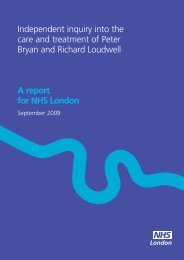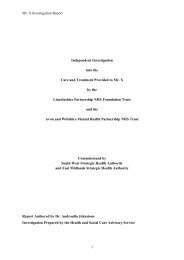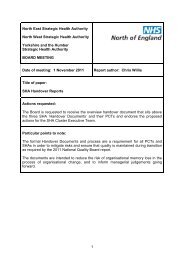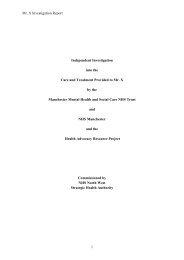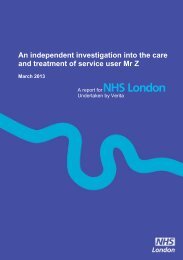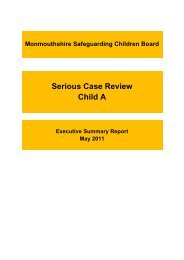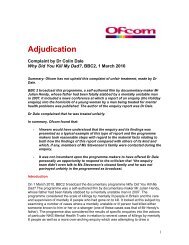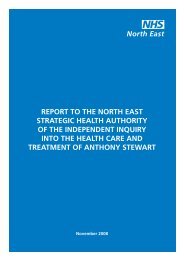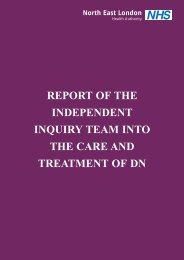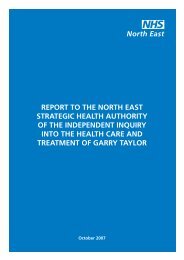Lousia Ovington independent investigation report ... - NHS North East
Lousia Ovington independent investigation report ... - NHS North East
Lousia Ovington independent investigation report ... - NHS North East
Create successful ePaper yourself
Turn your PDF publications into a flip-book with our unique Google optimized e-Paper software.
Chapter 5 – Involvement with police and probation<br />
Note: there are several references in this <strong>report</strong> to MAPPA (Multi Agency Public<br />
Protection Arrangements). It is a matter of great significance that in the case of<br />
Louisa <strong>Ovington</strong>, MAPPA was never invoked. The following, as an introduction to this<br />
chapter, should serve as a necessarily brief outline of the MAPPA process.<br />
MAPPA<br />
CHAPTER 5 – INVOLVEMENT WITH POLICE AND PROBATION<br />
The Criminal Justice and Court Services Act 2000 introduced a framework known<br />
as Multi-Agency Public Protection Arrangements (MAPPA), under which a duty was<br />
placed on the police and probation services (collectively known as ‘The Responsible<br />
Authority”) to work together to protect the public from convicted dangerous, violent<br />
and sexual offenders living within the community.<br />
The Criminal Justice Act 2003 extended the duty to the prison service, who then<br />
became the Responsible Authority jointly with the police and probation services. In<br />
addition to the duty on the Responsible Authority, this Act placed on various agencies<br />
including local authority social care services, primary care trusts, other <strong>NHS</strong> trusts and<br />
strategic health authorities a ‘Duty to Cooperate’ with the Responsible Authority.<br />
The aim of MAPPA is to enable the identification of the relevant offender, to provide a<br />
formal setting for the sharing of information, to undertake a rigorous risk assessment<br />
and to formulate and put into effect a robust risk management plan.<br />
The means by which these are achieved are, first, by establishing into which of three<br />
categories the offender fits, then managing the offender according to certain criteria.<br />
Rigorous risk assessment is a crucial part of the process - without accurate, up to date<br />
risk assessment the management of that risk cannot be robust or effective.<br />
There are three categories of offenders who may fit the criteria for MAPPA:<br />
1. Registered sex offenders as defined in the Sexual Offences Act 2003;<br />
2. Violent and other sex offenders who have received sentences of imprisonment of<br />
more than one year;<br />
3. Other offenders “who are considered by the Responsible Authority to pose a risk<br />
of serious harm to the public” 84 who is a category 3 offender is a matter of quite<br />
difficult judgement – the Guidance indicates that the person must have a<br />
conviction for an offence which shows s/he is capable of causing serious harm to<br />
the public and that the Responsible Authority must ‘reasonably consider’ that<br />
84 MAPPA Guidance Probation 2003<br />
99



